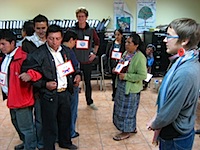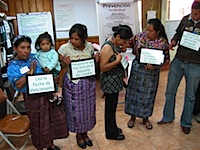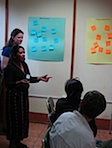Last week was a busy week, and a very exciting one for our Mayan coworkers. The Peace Corps received a big grant to increase AIDS awareness in Guatemala, so they invited all of us volunteers in the Health and Youth Development programs to bring two community leaders with us to a two-day AIDS awareness seminar. The idea is that by teaching the community leaders about AIDS, and specifically how to present the same seminar in their communities, word can get out about this dangerous disease that most Guatemalans have never heard about. Sadly, Guatemala has about 10,000 reported AIDS cases- but the World Health Organization estimates the real number is about 60,000.
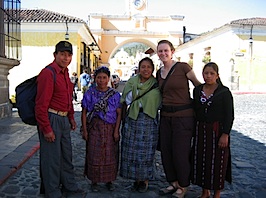 The seminar was held in Santa Lucia, at the Peace Corps headquarters/ training center. Part of the funding was travel expenses, food, and hotels for the participants. Since PC/HQ is about 10 minutes away from Antigua, and they put us up in hotels there, this had the pleasant side effect of being a PAID VACATION for everyone attending. One of the best parts of the week was when our four villagers arrived and Emily and I took them to their hotel. Three of the four had never been to Antigua before, and they all had their jaws on the floor. The youngest, Elisea, had never even left the departamento (state) of Huehuetenango before. “Have you ever seen so many gringoes?” I asked her as she made her way through the cobblestone streets, wide-eyed. She just shook her head no. Here’s a photo of our villagers, posing in front of one of Antigua’s more famous landmarks. Left to right: Manuel Jesús, president of the Health Comittee; his wife Abelina (with their baby on her back), president of the Womens’ Comittee; Lucia Diego, the nurse at our health post; Emily; and Elisea Juarez, an involved citizen who translates Q’anjob’al for us at charlas.
The seminar was held in Santa Lucia, at the Peace Corps headquarters/ training center. Part of the funding was travel expenses, food, and hotels for the participants. Since PC/HQ is about 10 minutes away from Antigua, and they put us up in hotels there, this had the pleasant side effect of being a PAID VACATION for everyone attending. One of the best parts of the week was when our four villagers arrived and Emily and I took them to their hotel. Three of the four had never been to Antigua before, and they all had their jaws on the floor. The youngest, Elisea, had never even left the departamento (state) of Huehuetenango before. “Have you ever seen so many gringoes?” I asked her as she made her way through the cobblestone streets, wide-eyed. She just shook her head no. Here’s a photo of our villagers, posing in front of one of Antigua’s more famous landmarks. Left to right: Manuel Jesús, president of the Health Comittee; his wife Abelina (with their baby on her back), president of the Womens’ Comittee; Lucia Diego, the nurse at our health post; Emily; and Elisea Juarez, an involved citizen who translates Q’anjob’al for us at charlas.
Our village is the farthest out of any of the participants, so we got the Peace Corps to fund our delegation for an extra night before the conference started. As it was, Manuel and his crew left our village at 3am. Since the buses don’t start until 6:15am, they walked an hour out of the valley in the dark to get to the main highway to catch an earlier intercity bus. This made it possible for them to arrive in Antigua before dark. There was some confusion, and the Peace Corps forgot to book their rooms for an extra night, so Emily and I put them up at the Dia Verde, a cheap backpacker hostel we use a lot when we have to go to Antigua. We know the manager, Vera, and she always treats us well. Once they were situated, we told them where to find comida tipica (local, Guatemalan food like beans and tortillas) since they wouldn’t be interested in spending big bucks on gross tourist food like nachos and pizza and hamburgers and spaghetti. Which makes my mouth water just thinking about it, and is the main reason Peace Corps volunteers ever go to Antigua.
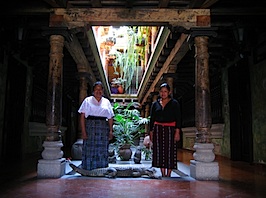 The next morning, we picked them up and moved them to their new hotel, a place WAY nicer than any Peace Corps volunteer could ever afford (Emily asked, and rooms there are 180q a night, or about $23). They were pretty blown away, and asked to have their pictures taken. We’re going to print them out so they can keep a recuerdo of their trip to the big city.
The next morning, we picked them up and moved them to their new hotel, a place WAY nicer than any Peace Corps volunteer could ever afford (Emily asked, and rooms there are 180q a night, or about $23). They were pretty blown away, and asked to have their pictures taken. We’re going to print them out so they can keep a recuerdo of their trip to the big city.
The conference itself was fun. Most of the Peace Corps volunteers had already seen the material; in fact, Emily Alta, Joe, Anne and I had to GIVE this workshop to 200 middleschool students during training. But this was about the Guatemalans. They learned about AIDS, but more importantly, learned techniques about presenting this infromation to others. It’s a tricky thing: the educational system here is one of rote memorization: teachers write on the board, students copy into their notebooks, everyone goes home. No one really learns anything. For topics of a sensitive nature, it’s even worse. Our teaching methodology is different; we do dynamic paticipative activities. Here we have our counterparts pretending to be white blood cells being attacked by the HIV virus. In the next picture, they are wearing signs describing the steps to putting on a condom, trying to rearrange themselves into the correct order. We also give everyone a chance to present part of the information, to become the teachers temselves.
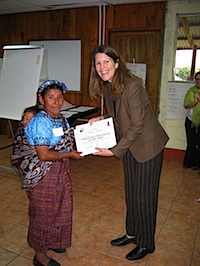 Now, you might think this is kindof edgy stuff for an ultraconservative society. IT IS! I was a bit worried how it would go over, but everyone seemed to get into it. At the end of the conference, we had a planning session where we worked out when we would give this seminar in our communities, to whom, and which groups would be likely to boycott. We eventually decided that we will give this seminar 4 times in April: once to the village leaders (I dread that one), once to the womens’ group, and twice to two different schools in the valley. Right before we went home, all of the participants got diplomas. Diplomas are a big deal to Guatemalans, since formalized education of any type is rare, and records aren’t well kept by educational institutions. Oftentimes a diploma is the only proof you have.
Now, you might think this is kindof edgy stuff for an ultraconservative society. IT IS! I was a bit worried how it would go over, but everyone seemed to get into it. At the end of the conference, we had a planning session where we worked out when we would give this seminar in our communities, to whom, and which groups would be likely to boycott. We eventually decided that we will give this seminar 4 times in April: once to the village leaders (I dread that one), once to the womens’ group, and twice to two different schools in the valley. Right before we went home, all of the participants got diplomas. Diplomas are a big deal to Guatemalans, since formalized education of any type is rare, and records aren’t well kept by educational institutions. Oftentimes a diploma is the only proof you have.
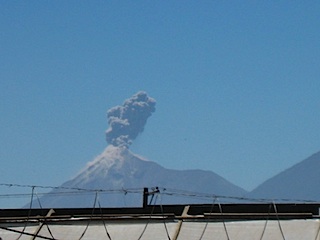 Everyone had a great time, and will probably go home with a lot of stories for their friends and neighbors, as well as memmories that will last for a long time. The day we left, one of the volcanos that surrounds Antigua (Volcán Fuego) exploded, as a farewell. It does that sometimes. Guatemala is cool that way.
Everyone had a great time, and will probably go home with a lot of stories for their friends and neighbors, as well as memmories that will last for a long time. The day we left, one of the volcanos that surrounds Antigua (Volcán Fuego) exploded, as a farewell. It does that sometimes. Guatemala is cool that way.
